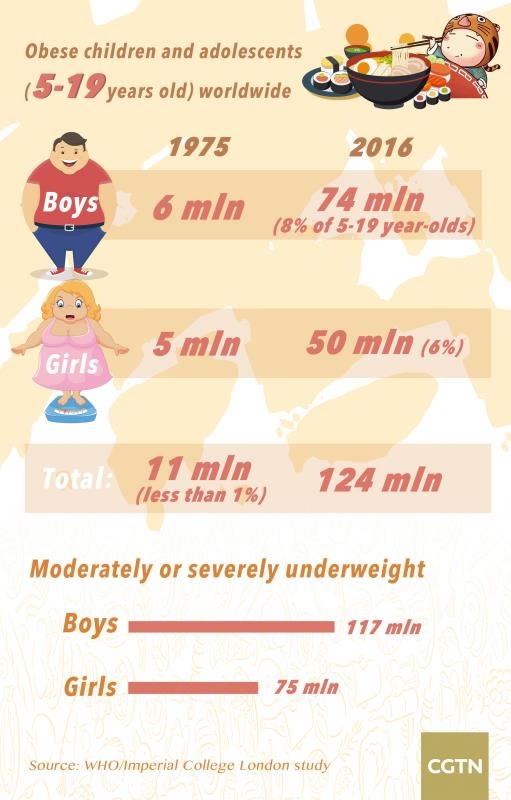
Business
15:42, 11-Oct-2017
Fighting the fat: Counting the cost of childhood obesity
by Nicholas Moore

A study released Wednesday by the World Health Organization (WHO) to mark World Obesity Day has shown that since 1975, childhood obesity rates have risen 10-fold.
As well as the potential health problems facing some 124 million obese children and adolescents worldwide, soaring obesity rates will also come with an ever-increasing price tag for governments, families and the wider global economy.
The World Obesity Federation (WOF) reported earlier this week that by 2025, obesity will cost 1.2 trillion US dollars per year, when taking into account treatment for issues like bone and joint problems as well as obesity-linked cancer, diabetes and heart problems.
With high healthcare costs, the US is set to face the highest bill for its obesity epidemic (an annual cost of 555 billion US dollars per year by 2025). However, low- and middle-income countries arguably face greater pressure, with struggling healthcare systems already barely coping with spiraling treatment costs related to obesity.
19,000 US dollars per child
A 2014 study by Duke Medicine estimated the lifetime cost of childhood obesity to be between 12,900 and 19,000 US dollars per child, when taking into account likely treatment for diabetes, cancers and heart conditions.
The WOF’s policy director Tim Lobstein told The Guardian that “for middle income countries we are going to see an enormous impact.”
The WHO’s report found that high-income countries’ childhood obesity rates had plateaued at high levels since 2000, but “children and adolescents have rapidly transitioned from mostly underweight to mostly overweight” in middle-income countries in East Asia, Latin America and the Caribbean.

/CGTN Graphic
/CGTN Graphic
In China, a 2016 study led by Shandong University Institute of Preventive Medicine and the European Society of Cardiology found that childhood obesity rates in the province had soared to such an extent that researcher Professor Joep Perk described the findings as “the worst explosion of childhood and adolescent obesity that I have ever seen.”
As of 2014, one in six boys and one in 11 girls in the province were obese, compared to less than one in 100 just three decades earlier.
490 billion yuan per year by 2030
The China Childhood Obesity Report, released in May this year by Peking University’s School of Public Health, found that by 2030, 56.12 million children under 18 in the country could be classified as obese.
In economic terms, the report estimated that the price of obesity in China will reach 490 billion yuan (74.4 billion US dollars) per year by 2030, a massive increase since 2002 (211.1 billion yuan).

Young people on a weight-loss program in Zhengzhou, Henan Province, August 2017. /VCG Photo
Young people on a weight-loss program in Zhengzhou, Henan Province, August 2017. /VCG Photo
If the 12,900 US dollar lower estimate of the lifetime cost of childhood obesity is applied to China’s 56.12 million obese children, the 2030 generation would mean a treatment bill of almost 724 billion US dollars for obesity-related illnesses during their lifetimes.
While Duke Medicine’s study was based on US healthcare costs, the cost of childhood obesity in China is still set to be hundreds of billions of US dollars in the coming decades.
Healthy China 2030
So what can be done to offset the economic cost of childhood obesity?
Peking University’s study estimated that “comprehensive intervention” would mean savings of 54,809 yuan (8,325 US dollars) per child, when taking saved medical costs, improved life quality and the costs of preventative programs into account.
In August 2016, the Political Bureau of the Communist Party of China Central Committee reviewed and approved the Healthy China 2030 plan, making the nation’s health a national priority.
The health blueprint, released in October that year, highlighted nutrition and physical activity as key areas for improvement, with health education set to be introduced into the national curriculum.

Increasing physical activity is a key aim of the Healthy China 2030 blueprint. /VCG Photo
Increasing physical activity is a key aim of the Healthy China 2030 blueprint. /VCG Photo
While activities like “fat camps” for overweight and obese children have attracted media attention in recent years, it remains unclear how effective they are in fighting obesity.
According to China Daily, sedentary lifestyles, urbanization and cultural differences mean that China’s childhood obesity has sky-rocketed in recent years, and a rural-urban divide is emerging when it comes to implementing measures to prevent obesity.
Related stories:

SITEMAP
Copyright © 2018 CGTN. Beijing ICP prepared NO.16065310-3
Copyright © 2018 CGTN. Beijing ICP prepared NO.16065310-3